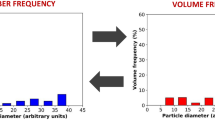Abstract
Analysis of particle size distribution of a sample of fine aluminum hydroxide powder was carried out by four different methods,i. e., conductivity, air permeability, gas-adsorption and sedimentation. Each method was reproducible. The results obtained by Coulter counter and sedimentation balance were similar, and the data obtained by Lea and Nurse permeameter and Stroehlein areameter were also similar. But the results differ considerably between the former and the latter. The advantages and disavantages of each method were discussed briefly and a means of comparing the results with those obtained by surface area measurements was shown.
Similar content being viewed by others
Literature Cited
Bean, H. S., Carless, J. E., and Beckett, A. H., “Advances in Pharmaceutical Sciences” Vol. 2, Adcademic press, London (1967).
Allen, T., “Particle Size Measurement”, 2nd ed., Chapman and Hall, N. Y. (1975).
Thornton, M. J., The size analysis of phenothiazine.J. Pharm. Pharmacol. 11, 127 T(1959).
Edmundson, I. C., and Tootil, J. P. R., Determination of specific surface area by airpermeation.Analysit,88, 895(1963).
Brunauer, S., Emmett, P. H., and Teller, E., Adsorption of gases in multimolecular layers.J. Am. Chem. Soc. 60, 309(1938).
Swintosky, J. V., Riegelman, S., Higuchi, T., and Busse, L. W., Studies on pharmaceutical powders and the state of subdivision. 1). The adsorption of low-temperature nitrogen adsorption isotherms to the determination of surface areas.J. Am. Pharm. Assoc. Sci. Ed. 38, 210 (1949).
Swintosky, J. V., Reigelman, S., Higuchi, J. and Busse, L. W., Studies on pharmaceutical powders and the state of subdivision. II). Surface area measurements of some pharmaceutical powders by the low-temperature nitrogen adsorption isotherm technique.ibid. 38, 308(1949).
Swintosky, J. V., Riegelman, S., Higuchi, J. and Busse, L. W., Studies on pharmaceutical powders and the state of subdivision. III). An evaluation of pharmaceutical dispensing techniques employed to increase the specific surface areas of powders.ibid. 38, 378(1949). 0
Hatch, J., and Choate, S. P., Statistical description of the size properties of non-uniform particulate substances.J. Franklin Inst. 207, 369 (1929).
Lea, F. M., and Nurse, R. W., Permeability methods of fineness measurement.Trans. Inst. Chem. Engrs. 25, 47(1947).
Bryant, D. P., and Evans, R., “Welwyn Hall Research Association, Research Report 31” (1966).
Author information
Authors and Affiliations
Rights and permissions
About this article
Cite this article
Min, S.H. A study on analysis of particle size distribution. Arch. Pharm. Res. 3, 65–74 (1980). https://doi.org/10.1007/BF02855805
Received:
Issue Date:
DOI: https://doi.org/10.1007/BF02855805



